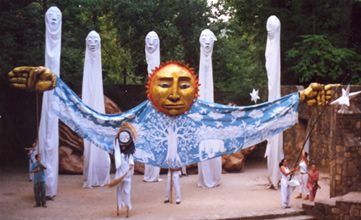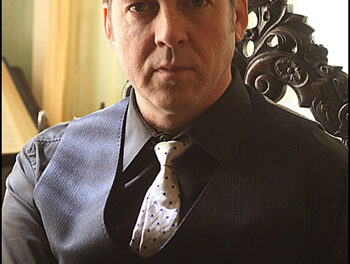After thrice circling the 700 blocks of North Main and Liberty Streets in Winston-Salem on August 13, I was hardly prepared for what turned out to be a literally scintillating Schubertiad, the second “Wednesdays Up-Close” concert of the Foothills Chamber Music Festival. Inside what is now a drab and dreary-looking warehouse is the spic and span and radiant gallery of art glass sculptor Jon Kuhn. Many of the pieces on display are clear glass cubes with multicolored glass matrixes within them that can rotate freely. Dominating the concert area was a huge mobile-cum-chandelier consisting of freely rotating polygonal icicle-like pendants. The larger ones had multi-colored elements that led to a myriad variety of colors from both reflected and refracted light. A musician mused that it might overwhelm the music. Had the evening been devoted to Hummel or Spohr, that would have been a problem, but the endless font of Schubert’s melodic invention and the crystalline quality of the piano colors rendered by the bright Boston instrument more than counterbalanced the light show. (Explore http://www.kuhnstudio.com/ to get a sense of this unique concert venue.)
The program insert was a quite Spartan listing of the works to be played and only English translations of the songs. With a 7:00 p.m. start and playing straight through, the concert was over by 8:30 p.m., allowing for a leisurely tour of the gallery or a timely retreat.
The nineteen-year-old Schubert composed four works for violin and piano around 1816 – three sonatinas and the Duo in A Major. Brian Newbould, in Schubert: The Music and the Man, describes “all three (as) compact works with movements of traditional generic type, broadly eighteenth-century in scale and outlook. The second and third run to four movements, having a minuet which the first lacks.” The third Sonatina, in G Minor, D.408, received a dramatic reading from violinist Margaret Soper Gutierrez and pianist Byron Schenkman. The piano lid was fully up but the keyboard was kept in perfect balance, never covering the violin. The playing of the pianist, also a noted harpsichordist, was particularly clear and elegant. Gutierrez’s intonation and phrasing was excellent, and the warmth of her lower range was beautifully displayed in the slow second movement. The Menuetto was far from a straightforward minuet, having assertive and faster portions.
Festival co-founder Rachel Matthews accompanied soprano Marilyn Taylor, a faculty member of the NCSA, in seven of the composer’s finest songs. We have admired her work as a soloist in choral works accompanied by the Winston-Salem Symphony and in a fine recital, with Jane Hawkins, of Charles Vardell’s music that toured much of the state and was heard at Piccolo Spoleto in Charleston, S.C., several seasons ago. I followed each Schubert song in the original German in The Fischer-Dieskau Book of Lieder , and Taylor’s diction was flawless. Her voice is very evenly supported throughout its range and her high notes were superb. She scaled the voice down for the more intimate art songs. For most she used restrained but appropriate expressions and gestures. “Lachen und Weinen” (“Tears and Laughter,” in the Fischer-Dieskau book) was given as a mini-drama with the full play of conflicted mood and physical expression. Based on this, I’d love to see and hear her in an operatic role. Matthews perfectly evoked rippling water in the prelude to “Auf dem Wasser zu Singen” (“To Be Sung on the Water”) and again in the ever-popular “Die Forelle” (“The Trout”), in which Taylor brought out the light-hearted humor. Her performances of the three refrains, with their long-sustained notes, were particularly memorable. As the full realization of rejection hit home, “Du liebst mich nicht” (“You love me not”) built in intensity after having begun slowly and darkly. The mood shifted with the slow, somber “Nachtviolen” (“Dame’s Violets”) and again in the agitated “Rastlose Liebe” (“Restless Love”). The sequence came to a quiet conclusion with “Du bist die Ruh” (“Repose You Are”). For the songs, the piano lid lowered to about ten inches. The instrument’s brightness and the gallery’s lively acoustics (stemming in part from its many hard surfaces) helped preclude any dull or muffled sound qualities.
Schubert’s compact piano four hands masterpiece, the Fantasy in F Minor, D.940, crowned the evening. Matthews sat on the left side of the bench, joined by Schenkman on her right. In the notes to their CD recording, Richard and John Contigulia, the duo-piano team, write that “the opening theme is one of the most haunting in all of music…. [T]he piano writing throughout most of the Fantasy is highly contrapuntal, incorporating invertible counterpoint and canons in the opening section and in the ‘Scherzo and Trio’ and a double fugue with two countersubjects in the final section.” The full sweep of this music through its “final wrenching cadence” was wonderfully sustained.












